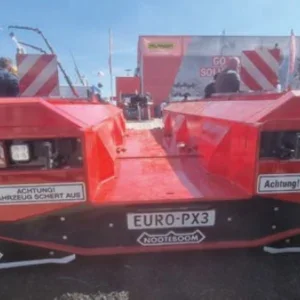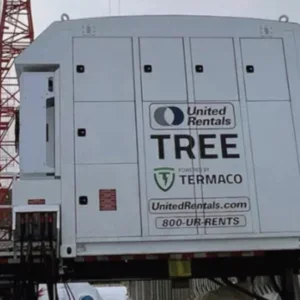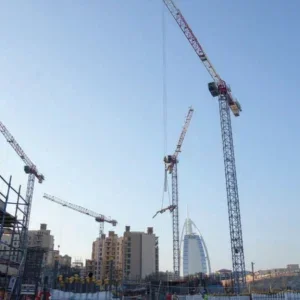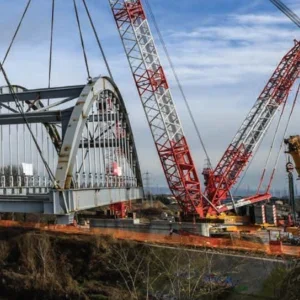For several years crane rental companies in the UK have been living with the now familiar problem of too many cranes chasing not enough work. While costs have gone up all around, rates have stayed the same for 10 years or more. Something had to give.
Then suddenly, at the back end of last year, came a series of transactions that might – just might – address some of these issues.
Last year saw even the big players, namely Baldwins, Ainscough, Hewden Stuart and Initial GWS, struggling. Even before the start of the year, back in August 1999, Initial GWS was put up for sale by its conglomerate parent Rentokil Initial.
Baldwins, having seen its share price rise strongly since its flotation in July 1999, began to struggle in 2000. It took a hit from the cost of shipping some big cranes across the Atlantic to its new operations in the USA and Venezuela. Time spent in transit meant several weeks with no return on the equipment.
Hewden Stuart, which hires out a full range of construction equipment and not just cranes, released three profit warnings during 2000 before accepting defeat and seeking a buyer.
Ainscough, the only privately owned company among the Big Four, called a halt to a period of heavy spending on new cranes and told Cranes Today’s June issue that trading conditions were “extremely difficult”.
By the end of the year, however, Rentokil Initial had agreed Ainscough’s offer for the mobile crane operation of Initial GWS (the crawler fleet having already been sold to Weldex) and Hewden Stuart’s board accepted a £322m ($458m) approach from Finning International, the Canadian-owned Caterpillar distributor. These two deals could change the face of the mobile crane hire industry in the UK, especially if Finning decides to sell Hewden’s cranes.
Finning’s official position is firmly that it will not. Executive vice president Rick Mahler said that it planned to “operate all facets of Hewden, including crane hire”. But with the purchase of Hewden seemingly engineered to add more Caterpillar machines to the construction equipment hire market, it is possible that the crane side of the business may be deemed surplus to requirements. Certainly Baldwins chairman Richard Baldwin thinks this way; he has already expressed his desire to buy Hewden’s mobile and tower crane operations should Finning wish to sell. Finning has acted as a Grove dealer in certain territories, including Canada in the 1980s and Chile currently, but generally it has not previously shown a great interest in the crane industry.
Thus the market has gone from the Big Four to the Big Three and there remains the possibility of it being whittled down to the Big Two. According to Richard Baldwin, the UK market is suited to this development. “Historically, it has been a better market place with two or three big players,” he says. “I think we will soon see some consolidation and the older equipment being sold out of the market.” Baldwins is contributing to the national need by moving a few of its larger cranes to the Americas and reducing the oversupply in the UK, but the major clear-out has been conducted by Ainscough in the wake of its acquisition of GWS. The combined fleet of 600 units was more than Ainscough can use and so almost immediately about 140 were disposed of. Liebherr took all the unwanted cranes off Ainscough’s hands and shipped them out of the country to auction in exchange for 23 new Liebherr all-terrains.
According to Richard Baldwin, this reduction in the UK crane population will lead to a rise in rates (and, no doubt, a rise in Baldwins’ share price). While this seems an entirely rational assessment, the crane hire industry rarely seems to behave entirely rationally. There is no shortage of cynics among the medium sized and smaller hire companies who believe that nothing will actually change.
Crane purchase prices and operator salaries have risen steadily over the years. And Ainscough has just awarded another pay rise to its operators as part of a restructuring of working hours and to bring its own operators in line with their new colleagues from GWS. On top of this, last year the price of diesel fuel went up from 13 pence a litre to 27 pence a litre. (That is roughly equivalent to $1.53 a gallon.) Without passing these costs onto customers, there will be no crane hire industry in the UK. But no one seems to have been able to make rate rises stick. Ainscough, Hewden and Baldwins may be strong enough to push forward with rate increases now, but there are many smaller companies outside the major league that have to take whatever they can get.
“We are our own worst enemy,” admits David Kitson, managing director of Westcountry Crane Hire. “There’s no logic to this industry. It’s every man for himself and we all undercut each other.” Kitson says that hire companies will take any fee for a job if the crane needs work. “The rates change from day to day. We try to get the best rate on the day, depending on which crane is available.” As long as the crane is out of the yard, you have a chance of staying in business.
“You have to pay the operator anyway,” says Kitson. “I’d rather have him out doing a job than washing the machine and drinking tea.” Peter Goodrick blames the manufacturers for the oversupply of equipment. Goodrick is a director of Chamberlain Plant Hire, a small company which claims to be the oldest crane rental company in the UK. He argues that the European mobile crane manufacturers – principally Grove, Liebherr, Dematic, Faun and PPM – give such good terms to the major rental companies, often including a year’s credit, that these new cranes can go out on hire at below their market rate. So not only is the market being flooded with cranes it cannot sustain, but these cranes do not even have to achive a proper yield. Smaller customers are not always treated so kindly.
Bill Frost, managing director of Bronzeshield, disagrees with this analysis. “Ten years ago, yes, the manufacturers were to blame. But that is not the case now.
“There is no overpopulation of cranes in the taxi class,” says Frost, though there are too many heavy lifters for the market, he acknowledges. For example, in 1994 there were four 400t cranes in the UK, but within two years there were eleven, Frost says.
But it is the buyers, not the sellers. who are to blame, he believes. “The reason there are too many cranes is that the rental companies are buying too much,” says Frost.
David Kitson concedes this point too: “I’m as guilty as anyone. If I think I have not got enough cranes I’ll buy more and then next week I will have too many.” Anyone visiting the UK construction equipment exhibition SED in Milton Keynes last May could be forgiven for thinking that the UK market was very healthy, such was the dispaly of new cranes. Behind the scenes, however, were a lot of frantic late deals to ensure cranes were ‘sold’ to UK customers in time to bring to the show. And in fact sales of new mobile cranes were down about 10% in 2000, following a similar 10% decline in 1999.
Demand for lifting services is still reasonably strong, though. Developments alongside the Thames in London, the construction and upgrade of various sports stadia around the country and recent extreme weather are providing ample work for crane owners.
So after a difficult few years for those in the industry, there may be hope of a better 2001, although as Bill Frost says: “You’re going to need a crystal ball to see how this will all end up.”






